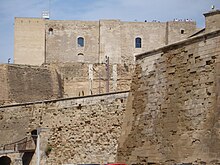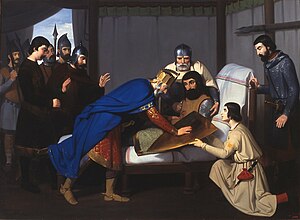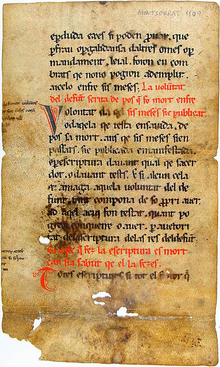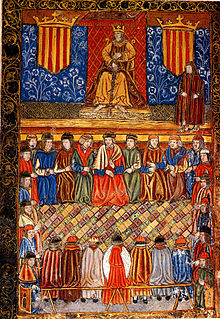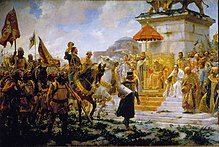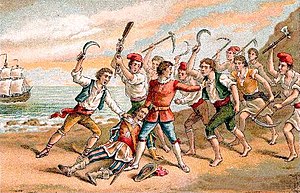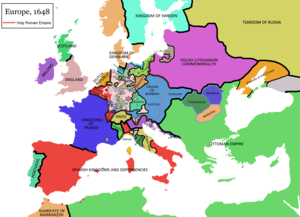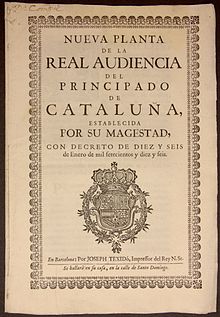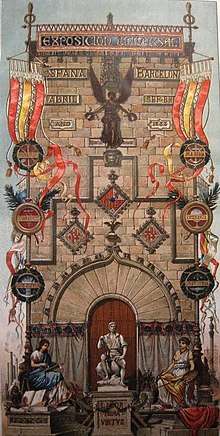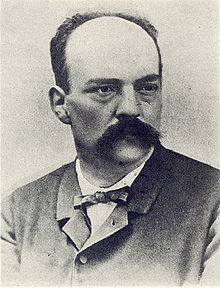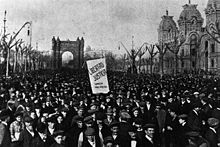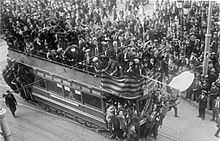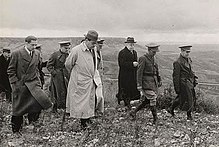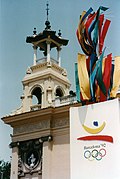History of Catalonia
Catalonia is a territory located in the northeast of the Iberian Peninsula initially formed from the counties that formed the Hispanic March of the Carolingian Empire and whose extension and unity was completed throughout the Ages Half. After the dynastic union of the County of Barcelona and the Kingdom of Aragon in the XII century, the Catalan territories became an integral part of the Crown of Aragon, reaching a notable maritime and commercial preponderance at the end of the medieval period. Currently, the word Catalonia is commonly used to refer to the autonomous community of the same name located in Spain, while both cultural institutions, such as the Institute of Catalan Studies and the University of Perpignan, as well as the Catalan media, speak of Northern Catalonia to refer to Roussillon, the region integrated into the Department of the Pyrénées-Orientales of France.
Prehistoric Period
The first settlers of the territory currently occupied by Catalonia date back to the beginning of the Middle Paleolithic. The oldest remains discovered correspond to the jaw of an individual of the genus Homo (uncertain species) found in Banyoles, about 6700 ± 1000 years old.
Among the most important sites from this period are the Mollet caves (Serinyà, Pla de l'Estany), the Cau del Duc, in the Montgrí massif, the Forn d'en Sugranyes site (Reus) and the Romaní i Agut shelters (Capellades), while for the Upper Paleolithic those of Reclau Viver, the Arbereda cave and the Bora Gran d'en Carreres, in Serinyà, or the Cau de les Goges, in Sant Julia de Ramis.
From the next prehistoric stage, the Epipaleolithic or Mesolithic, important sites have been preserved, most of them dating between 8000 and 5000 BC. C., such as Sant Gregori (Falset) and el Filador (Margalef de Montsant) and, with regard to the artistic-credential manifestations, Levantine Art, the Cogul, Cabra Feixet (el Perelló) and Ulldecona.
The Neolithic period begins in Catalan lands around 4500 B.C. C., although in a much lower degree of sedentarization of the inhabitants than in other places, thanks to the abundance of forests, which led to hunting and gathering continuing to be fundamental activities and the establishment of settlements being delayed in many places.. The most important Neolithic sites in Catalonia are the Fontmajor cave (l'Espluga de Francolí), the Toll cave (Moià), the Gran i Freda de Montserrat caves and the shelters with schematic art of Cogul, Os de Balaguer, Albi, Tivissa and Alfara de Carles.
The Chalcolithic or Eneolithic period took place in Catalonia between 2500 and the XVIII century B.C. c.|1800 a. C.]], moment in which the first copper objects are built.
The Bronze Age is placed chronologically in the period 1800-700 B.C. C., of which few remains are preserved, but some towns formed in the Bajo Segre area stand out. The Bronze Age coincides with the arrival of the Indo-European peoples, through successive migratory flows that develop from the year 1200 a. C., responsible for the creation of the first towns with a proto-urban structure.
From mid-century VII a. C. the Catalan territory reaches the period known as the Iron Age.
The Old Age
Protohistoric Period
This period is characterized, in a first stage, by the confluence of different colonizing cultures in the current Catalan territory, particularly the Greek and the Carthaginian, which will give rise to the formation, as in the rest of the peninsula, of Iberian culture. From this stage is the formation of Emporion, on the Girona coast, a commercial enclave promoted by the Greek city of Focea from Massalia (present-day Marseilles), in the VI a. C..
As far as Iberian civilization is concerned, the existence of different tribes scattered across Catalan lands has been confirmed, including the Indigetes (in Ampurdán), the Ceretanos (in Cerdanya) or the Airenosinos (in Valle of Aran). These peoples share a similar material culture and would presumably have spoken similar linguistic varieties, collectively called the Iberian language. Although there is a certain toponymy of Celtic origin, especially in the north of the territory.
There are four major periods in the current territory of Catalonia. The initial, spanning the 8th century to the VII a. C., which corresponds to a stage of formation, in which the indigenous peoples come into contact with colonizing peoples, and in which the first iron objects appear. The second is the ancient period, from the VII century BCE. C. mid-V a. C., in which the Iberianization process is consolidated. A period of fullness follows, from the middle of the V century to the III a. c. And, finally, the phase of decadence, which begins in 218 B.C. C. with the presence of Rome, in which the Iberian culture is absorbed by the powerful impulse of Romanization.
Roman Period
The second stage of the ancient history of Catalonia corresponds to the Romanization period, which began in the III century B.C. C. The arrival of the Romans to the Iberian Peninsula took place in 218 BC. C., with the landing of Gnaeus Cornelius Scipio in Emporion, the current Ampurias, with the aim of cutting off the sources of supply for the armies of the Carthaginian general Hannibal during the Second Punic War. The main base of operations for the Romans during the war, and the first nucleus of Romanisation on the peninsula, was the city of Tarraco, present-day Tarragona.
After the defeat of the Carthaginians and different Iberian tribes in revolt before the Roman presence, in 195 BC. C., the Roman conquest in Catalan territory was practically completed and the Romanization process began, through which the different peninsular peoples were assimilated by Roman culture and abandoned their own features.
The current Catalan territory was first included in the province called Hispania Citerior, to form part from 27 a. C. de la Tarraconense, whose capital was Tarraco. A province that covered about two thirds of the Iberian Peninsula, and included the regions to the north and south of the Ebro, from the Pyrenees in the north to Sagunto in the south, the Duero Valley, except for the area of its southern shore between the Tormes and its mouth in Cale (Porto, Portugal), the Tagus and Guadiana valleys up to the limits with Lusitania, and the eastern end of Andalusia, east of the Baetica border that ran from Cástulo (Linares), passing through Acci (Guadix) to La Bahía de Almería, leaving these areas (which for several years belonged to the Baetica) in Tarragona territory; to the east it was bordered by the mare Nostrum –Mediterranean Sea–, and to the west by the Atlantic Ocean and to the north by the Cantabrian Sea and the Pyrenees mountain range, which separated it from southern Gaul, that is, from the Roman provinces of Aquitaine and Gallia Narbonensis.
Product of the Roman period will be the adoption of the entire administrative structure and Roman institutions, the development of a large urban and road network, the generalization of an agricultural system based on the Mediterranean trilogy (cereals, vineyards and olive trees), the introduction of irrigation, the development of Roman law and the adoption of Latin.
Late Antiquity to Feudal Period
3rd and 4th centuries
The crisis of the 3rd century that affected the Roman Empire and that would cause its decline seriously affected the current Catalan territory, where significant levels of destruction and abandonment processes of Roman villas have been detected. Also from this century are the first documentary news of the presence of Christianity in Catalonia. Although archaeological data indicates the recovery of some nuclei, such as Barcino (Barcelona), Tarraco (Tarragona) or Gerunda (Gerona), the situation was not what it was before, the cities were walled in and the nuclei shrank.
Visigothic period: 5th to 7th centuries
In the V century, there is a general invasion of the Roman Empire by the Germanic peoples. The Germanic people of the Visigoths who had obtained permission to enter the Empire and collaborate in the defense of the limes in present-day Bulgaria as Roman allies; They were led by Ataúlfo after the situation of marginalization within Roman society and the extreme poverty of this ethnic group. Ataúlfo was a Visigoth and Roman general who reached the highest military ranks within the Roman army, and who led the Visigothic rebellion, reaching Italy and Rome, defeating or dodging the Roman legions, and managing to conquer the hitherto undefeated city of Rome (second sack). As an agreement between the Romans and the Visigoths and for them to return to accept the Roman order, its laws, to stop looting Italy, and to become faithful allies again, Hispania and part of France are given to them. The Visigoths reached the Iberian Peninsula by the main Roman road, settling in the city of Tarragona in (410). And when in 475 the Visigothic king Eurico formed the kingdom of Tolosa, he incorporated the current Catalan territory, with government first from Tolosa and then from Toledo.
Muslim conquest: 8th century
The Visigoths dominated the territory until the beginning of the VIII century, when in the middle of a civil war for the succession of the kingdom (which then already covered the entire Iberian Peninsula), one of the parties calls on the emerging power, the Umayyad Empire, for help and to decide the war in their favor. The Muslims already occupied all of North Africa and their empire stretched as far as India. After defeating the troops loyal to the Visigothic king, Roderic (don Rodrigo), in the battle of Guadalete and with the support of the rebellious Visigoths who aspired to power, they quickly conquered the peninsula, finding only marginal resistance in the northern mountainous areas. The Muslim lightning conquest was based on an army of 30,000 men (the Romans had had an army of 50,000 for the defense of the Western Empire and another 50,000 for the defense of the Eastern Empire); in highly motivated soldiers; in the light cavalry tactics that worked so well in open terrain; in the weakness of a kingdom divided in the middle of a succession civil war; in the disinterest of a Hispano-Roman population dominated by an aristocratic Visigothic minority that had not managed to integrate them into the kingdom (the integration between the Visigoths and the local population did not take place until later times); in Christianity's religious mandate against war (which did not change until the late XI century with the rise of the class cavalry, about 1075, and the crusades from 1100); in the fear of reprisals accompanied by the tolerance of the Muslims with whom they submitted without resistance; in the facilities granted to the ruling classes to maintain power if they changed sides; in religious tolerance through the simple payment of a tax by non-Muslims; and, only in some cases, the delivery of land to the new conquerors (the best for the Arabs and Yemenis, the worst for the Berbers).
In 718, the Muslim conquest of the Iberian Peninsula reached the northeast of the peninsula and passed into Visigothic Septimania, a process that took place without serious warfare, except for some isolated pockets of resistance such as Tarragona. Muslim power extended through Gaul as early as 719, Narbonne, Carcassonne, to Tolosa, and even Bordeaux, in a continuous expansion to central Europe. The subsequent Carolingian reaction led by Charles Martel, Duke of Eudes, with his powerful army of heavy cavalry (in mail), halted the Muslim expansion into Europe at the Battle of Toulouse in 721, driving them back in the aftermath of the battle of Poitiers in 732, reaching the liberation of Narbonne in 759 by Pepin the Short.
Carolingian conquest and formation of the Hispanic March
The reaction continued with the process of creating a defensive march to serve as the southern border for the Carolingian Empire. This led to the occupation by the Franks during the last quarter of the VIII century of the current Pyrenean regions, Gerona and, in the 801, from Barcelona, after which a border region was formed that roughly followed the course of the Llobregat and Cardener rivers and the middle course of the Segre. The domains of the Carolingian Empire delimited by this border area with Al-Andalus and the Pyrenees would be known by the name of the Hispanic Brand, although unlike other Carolingian brands it was never formally established as such. This territory was politically organized into different counties dependent on the Frankish king.
9th century
At the end of the IX century, the Carolingian monarch Charles the Bald appointed Wifred the Hairy, a nobleman descended from a family of the Conflent, count of Cerdanya and Urgell (870), and count of Barcelona and Gerona (878), which meant the reunion under his command of a good part of the territory of the Hispanic March. Wifredo was the first count to transmit the government of his territories directly to his descendants, due to the crisis in which the Empire was plunged and the consequent increase in power of local rulers in the border territories. Although Wifredo distributed his counties among his sons upon his death, unity was maintained between Barcelona, Girona and Osona, except for a brief period. Wifredo's policy is attributed to the repopulation of Osona, as well as the founding of the monasteries of Ripoll and San Juan de las Abadesas, and the restoration of the episcopal seat of Vich.
Independence of the Catalan counties: 10th century
During the X century, the counties became true independent counties of the Carolingian power, according to the central power of the Empire it was weakening, and the civil wars, of succession, did their work of wearing down, a fact that Count Borrell II made official in 987 by not taking the oath to the first monarch of the Capetian dynasty. counties, the first steps of repopulation of the territory were developed after the Muslim invasion, bringing large contingents of population from the territories within the Carolingian Empire that were domains owned by the Counts of Barcelona as subjects of the Empire, the repopulation was done mainly with population from southern France (the differences with the current population of southern France come from the annihilation of this population in the wars against the heresy of the Cathars, and the repopulation with inhabitants from northern France). Thus, during the centuries IX and X a society was created where small freeholders, called aloers, predominated, framed in an agrarian society where each family nucleus produced what it consumed, generating very few surpluses, and typical of the Age Half.
Feudal Catalonia: 11th century
The XI century in Catalonia is characterized by the development of feudal society, as a consequence of seigneurial pressures to develop ties of vassalage with free peasants (alodiales, in Catalan aloers). The central years of the century were characterized by a virulent social war, where seigneurial violence overwhelmed the peasants, thanks to the advantages they obtained from the new military tactics, heavy cavalry, and based on the hiring of well-armed mercenaries on horseback.
Thus, by the end of the century, most of the peasant owners had become serfs subject to the lord. This process coincided with a weakening of the power of the counts and the division of the territory into numerous lordships, which over time would give rise to the articulation of a feudal State based on complex allegiances and dependencies, at the top of which would be found the count of Barcelona, after the triumph over the rest of the lords of Ramón Berenguer I. Over time, the counts of Barcelona would link all the other Catalan counties with the county that would later become part of the Crown of Aragon.
It is also in this period, during the XI century, when the Taifa of Tortosa and the Taifa of Lérida were consolidated.
Expansion of the Catalan counties: 12th century
Until the middle of the 12th century, the successive counts of Barcelona tried to expand their territories in multiple directions and by various means. Ramón Berenguer III (1082-1131) incorporated the county of Besalú (1111) by marriage, inherited that of Cerdanya (1117 or 1118), and forcibly conquered part of the county of Ampurias (between 1123 and 1131). Beyond the Pyrenees, he also controlled that of Provence (since 1112), which he bequeathed to his second son Berenguer Ramón when he died.For his part, in 1118 the Catalan Church became independent from the see of Narbonne and the church was restored. Tarragona headquarters.
12th to 15th century: The Crown of Aragon
Under the government of Count Ramón Berenguer IV (1131-1162), different fundamental events took place in the history of Catalonia. The first, his wedding with Petronila de Aragón, which meant the dynastic union of the county of Barcelona and the Kingdom of Aragon, so that over time the common territory would be called the Crown of Aragon. As a consequence of such a type of union, the kingdoms, states, domains or titles thus united were not integrated or merged, but rather the same people owned each of them independently; and, in general, the domains of the title maintained their own institutions and legislation (particularismo). According to what was agreed in the marriage capitulations of Barbastro in August 1137, Ramón Berenguer became the princeps or dominator of Aragon, since the Aragonese king Ramiro donated his daughter and his kingdom to him for to have her and the kingdom in control «save fidelity to me and my daughter» («dono tibi, Raimundo, barchinonensium comes et marchio, filiam meam in uxorem, cum tocius regni aragonensis integritate [...] salva fidelitate mihi et filie mee.»), and retired to monastic life. According to these capitulations, Ramiro did not give up his royal dignity, that is, that from now on he would be king, lord and father of Ramón Berenguer both in Aragón and in all his counties.
sim rex, dominus et pater in prephato regno et in totis comitatibus tuis, dum mihi placueritI will be king, lord and father in the same kingdom and in all your counties as I please.
However, in November of the same year, 1137, Ramiro renounced everything that had been reserved in the Capitulations of Barbastro,
Et ut in hoc nullum occasionis vel pessime machinationis ingenium ab aliquo possit intelligi, totum eti dimitto; dono atque concedo quicquid retinueram in ipsa alia letter donacionis regni quam ei antea feceram, cum filiam meam ei dedissemAnd so that nothing can be thought of or machined by anyone, I donate to him, I grant and grant all that I had reserved in that same letter of donation that I had initially made to him, by giving him to my daughter.
The union in the Crown of Aragon, of the county of Barcelona and the kingdom of Aragon was not, then, the result of a merger or a conquest, but the result of an agreed dynastic union. In fact, the territories that made up the Crown separately maintained their own laws, customs, and institutions, and the reigning monarchs had to respect these bases.
On a dynastic level, there are various explanations in current historiography about the continuity of the ruling houses in the united Crown. Thus, some historians, such as Ubieto or Montaner, believe that there was an adoption by which Ramón Berenguer became one more member of the House of Aragón. On the other hand, José Luis Villacañas or Vicente Salas Merino, among others authors consider that the reigning dynasty between 1162 and 1412 was the House of Barcelona.
Henceforth, Ramón Berenguer IV materialized the new politically differentiated conquests assigned in his personal title as marquesados. He conquered Tortosa and Amposta in 1148, and Lleida in 1149 thanks to a joint offensive with Count Ermengol VI of Urgell. These territories were repopulated throughout the XII century and usually receive the generic name of New Catalonia, to distinguish them from the old counties Carolingians that made up the eastern area of the Hispanic March, called Old Catalonia. The line of separation between both geographical areas is usually established on the line delimited by the Llobregat rivers, its tributary the Cardener, and the Segre.
Expansion of the Crown of Aragon: 12th and 13th centuries
At the end of the XII century, different pacts with the Kingdom of Castile delimited the future areas where to develop new conquests of territory Muslim, but in 1213, the defeat of Pedro II the Catholic in the battle of Muret put an end to the project to consolidate the power of the Crown over Occitania. After a period of turmoil, in 1227, James I the Conqueror fully assumed power as heir to the throne of the Crown of Aragon and territorial expansion into new territories began. At its meeting in 1188, the Assembly of Peace and Truce, the germ of the Catalan Courts, had established the limits of what from the middle of the century XIV shall be known as the Principality of Catalonia, and shall be defined as the territory subject to the jurisdiction of said Courts. In said assembly, its jurisdictional scope was established "from Salses to Tortosa and Lleida and their rivers" (Constitution XVIII). However, both the western and southern borders had an uncertain definition for decades. Thus, delegates from the lands of Lleida and Fraga went to the Courts of Aragon convened by Jaime I in Daroca in 1228. In 1244, on the other hand, Jaime I set the border on the Cinca river, placing previously attached territories in the Catalan area to Aragon such as Ribagorza, La Litera and the Aran Valley. As for the southern limit, it was established in the lower course of the Ebro river, between the mouth of the Segre and the sea.
Throughout the second quarter of the XIII century, the Balearic Islands and Valencia were incorporated into the crown. This last territory, the Kingdom of Valencia, became one of the kingdoms of the Crown of Aragon, with its own courts and new jurisdictions: the Furs de València. On the other hand, the Mallorcan territory, together with the counties of Roussillon and Cerdanya, the city of Montpellier and the lordships of Omeladés and Carladés, would be inherited by his second son, Jaime, and they would form the Kingdom of Mallorca, thus beginning a period of internal tension that would end with its annexation to the Crown of Aragon in 1343, by Pedro IV the Ceremonious. In 1258, 29 years after the conquest of the Kingdom of Mallorca and 20 after that of the Kingdom of Valencia, the Treaty of Corbeil was signed in which King Louis IX of France renounced his rights over the Catalan counties, becoming part of the Crown of Aragon and James I to most of the counties in the north of the Pyrenees.
Between the final decades of the XIII century and the first decades of the XIV, the Catalan counties experienced periods of great abundance, in which they experienced strong population growth and maritime expansion across the Mediterranean. This period coincides with the reign of Peter III the Great, who invaded Sicily (1282) and had to defend himself against a French crusade against Catalonia; Alfonso III the Liberal, who seized Menorca, and Jaime II, who invaded Sardinia and with whom the power of the Crown reached its maximum economic expansion in the Middle Ages. However, from the second quarter of the XIV century, a sign change began for Catalonia, marked by a succession of natural catastrophes and demographic crises, the stagnation and recession of the Catalan economy and the emergence of social tensions.
Due to its borderline nature, Ribagorza continued to be the subject of dispute between Catalans and Aragonese during the 13th century. In the Cortes meeting in Zaragoza in 1300, King Jaime II approved that both Ribagorza and La Litera remain under Aragonese jurisdiction.
Creation of the Generalitat of Catalonia: 14th century
The reign of Pedro IV the Ceremonious (1336-1387) was characterized by serious war tensions, including the annexation of the kingdom of Majorca, the quelling of a Sardinian rebellion, the rebellion of the Aragonese and Valencian unionists and, above all, the war with Castile. These episodes generated a delicate financial situation, in a context of demographic and economic crisis, but also a powerful institutional and legislative development, in which the creation of the General Deputation of Catalonia or Generalitat of Catalonia (1365) stands out.
In 1375, a protest by Fraga's representatives before the Parliament meeting in Tamarite once again moved the western limit of Catalonia, since this city once again fell under the jurisdiction of Aragon.
End of the autochthonous dynasty of the counts of Barcelona: XV century
The death without issue and without the appointment of King Martin I the Human's successor in 1410 also caused a serious succession crisis. This opened a period of interregnum in which various candidates for the throne appeared. Commercial interests, as well as the animosity aroused by Jaime de Urgel, would end up favoring the candidate of the Castilian Trastámara dynasty, Fernando de Antequera, who, after the so-called Caspe Compromise of 1412, was named monarch of the Crown of Aragon. With the arrival of the House of Trastámara, the Spanish language began to be introduced in Catalonia.[citation required]
The successor of Ferdinand I of Aragon, Alfonso V the Magnanimous, promoted a new expansionist stage, this time over the Kingdom of Naples, which it finally dominated in 1443. At the same time, the social crisis in Catalonia worsened, both due to the rural and urban conflicts. The outcome of these conflicts was, in 1462, the rebellion of the remensas, carried out by the peasants against the seigneurial pressures and the Catalan civil war, which would last for a period of ten years, after which the region was exhausted, the remense conflicts were not resolved and France retained until 1493 the counties of Roussillon and Cerdagne, which were occupied during the conflict.
The marriage of Ferdinand II of Aragon with Isabel la Católica, Queen of Castile, celebrated in Valladolid in 1469, led the Crown of Aragon to a dynastic union with Castile, effective at his death in 1516, but both kingdoms retained their political institutions and maintained their own courts, laws, public administrations and currency. It would be Ferdinand II of Aragon, the Catholic, who, with the arbitration sentence of Guadalupe, resolved the remensa conflict in 1486, profoundly reformed the Catalan institutions, peacefully recovered the northern Catalan counties and expanded the crown's action over Italy.
16th to 18th centuries
16th century
Since the times of the Catholic Monarchs, Catalans have participated directly in Spanish expeditions and military campaigns. Admiral Cardona conquered Mers-el-Kebir (traditionally known in Spanish chronicles as Mazalquivir) in 1505. Pere Bertran i de Margarit, from Empordà, accompanies Columbus on his second voyage.
In the 16th century, the Catalan population began a demographic recovery and a certain economic recovery. The reign of Carlos I was for Catalonia a stage of harmony in the new structure that the Hispanic kingdoms now formed. In 1521 he appointed the Archbishop of Tarragona, Don Pedro Folch de Cardona, Viceroy of Catalonia.
When Carlos I of Spain arrived, a king who stayed on the peninsula for a short time, took Castile as his base of operations, with a population of 6 million (among the most populous kingdoms in Europe at the time), a thriving economy (Flanders, Portugal and Northern Italy were the other most developed economies on the continent), and the discovery of America by the Kingdom of Castile, and its new army, which thanks to the Great Captain was the most powerful in Europe, made it the perfect source for its expansionist and imperial ambitions, being the main base of taxes and recruitment of troops. While Catalonia, with its 300,000 inhabitants, was freed from carrying this heavy burden, in Castile the "revolt of the comuneros" was taking place due to new taxes to pay for the armies and bribes for the German Electors to be named Holy Emperor. Germanic Roman Empire, the largest amounts of gold paid up to the time, as well as because the petty nobility and the bourgeoisie had their sights set on overseas expansion, and not on the European expansion of the new king, who had been born and raised in Flanders (present-day Netherlands, Belgium and part of France). This revolt was crushed by the tercios that returned from Italy, with the support of the population of Navarre and the Basque Country (who received the king's privileges in gratitude for their support), and with the support of the great nobility, against the small nobility and the bourgeoisie of the cities. In the long term, military needs and high taxes, such as the alcabala that had to be paid every time a commercial or transport operation took place (10%+10+10+ is added to each operation..., not like the current VAT, which is only paid on the final sale), led the kingdom of Castile to bankruptcy. The advantage of the Crown of Aragon by avoiding the payment of these high taxes in favor of the king and for the defense of the kingdom (large numbers of troops or money were not sent), did not avoid having high taxes in the Crown of Aragon, although this time in favor of the nobles, and that they feared losing them in favor of the king.
The fact that the discovery of America and therefore the rights over it were in the kingdom of Castile, distanced the Crown of Aragon from its advantages until the unification with the kingdom of Castile with the arrival of the Bourbons in the War of Succession. Although the Kingdom of Aragon had opposed a unification with the kingdom of Castile, since the nobility that made up the courts of Aragon assumed that this would be a dilution of their powers, and having to bear the greater tax burden that the kingdom of Castile.
During the reign of Philip II, the Crown of Aragon continued without supporting the military maintenance of the kingdoms. This is explained by the refusal of the Crown of Aragon to provide more troops and funds to the king and the defense and expansion of its domains, as well as the shift of international political and economic weight from the Mediterranean to the Atlantic, the weakness of the principality of Catalonia, with the pre-eminence of the Kingdom of Valencia in the space of the old confederation being a matter of minor importance.
The reign of Felipe II would mark, instead, the beginning of a process of deterioration, the economic crisis that began in Castile in 1580 and the high taxes that gripped the neighboring kingdom, leading it to a great loss of population, reaching the plateau and except Madrid, to have less population today than before 1580; Catalonia's economy suffers, but the unity of the kingdom is maintained. Among the most negative elements of this period are Berber piracy on the coastal areas and banditry in inland areas. The new dynamics and the new loyalties that it generated also caused a setback in the Catalan language and culture, which began a period of decline, after the strength of previous centuries.
During the reign of Felipe II, there were Catalans, such as Luis de Requesens, who actively participated in the foreign policy of «Las Españas» (or of the Spanish kingdoms), both diplomatically and through the use of arms, as subjects of the crown and king
17th century
In 1600, and already since 1580, the economic crisis had undermined the peninsular kingdoms unified under a single king; the army, the tercios, were still an elite force, but they no longer had the overwhelming technological superiority of the 16th century, Northern Flanders had become independent and in America the Spanish kingdoms maintained their superiority, but suffered harassment from pirates and English, French and Dutch expansion. While in Asia, factories of Portuguese posts were lost, with the worst possible defense than the Americans (with a larger population loyal to the crown and with easy support among its parts). In this situation, the Thirty Years' War began in 1618, which would lead to Richelieu's France and the French as first-rate European powers, breaking the supremacy of the two superpowers up to the time (the Ottoman Empire and the Spanish Empire). Europe passes to the balance between powers; and this thanks to the skill in international politics of Richelieu, to the money of the Kingdom of France, to the religious division and to the military power of the kingdom of Sweden, which printed the first defeat in a pitched battle to the tercios. In 1648, at the end of the Thirty Years' War, after the Peace of Westphalia, a new world of balances of power opens up.
Uprising of Catalonia (1640)
The economic crisis, new taxes and new military needs lead to a popular uprising in Catalonia. The basic reasons are of two types, firstly due to the so-called "old causes" (reduction of the medieval privileges of the nobility since the union of Aragon and Castile, non-convening and presidency of the Catalan Courts, introduction of some of the taxes that were paid in Castile, and the introduction in Barcelona of the new Inquisition to replace the old Inquisition that had already been operating since the Middle Ages, and which was the model by which the Inquisition was established in Castile at the time of the Kings Catholics); and "new causes" (the presence in Catalan territory of foreign troops paid by the king, considering as such Castilian and Aragonese necessary to defend the borders against France in the war, but never desirable in your territory, and the performance of public offices by non-Catalan people. And secondly, by the centralizing policy of the Count-Duke of Olivares, who sought to unify the kingdoms of Aragon and Castile, reorganize and raise the payment of taxes to maintain the thirty-year war. main problems in economic crisis, the malaise of the war, the presence of troops to protect the border against France, given the abuses of the armies of the time; and the request for new taxes and levies to maintain the military effort during the war.
During the war between France and Spain since 1635, the French invaded Roussillon under the command of Condé and seized the town and the Plaza de Salses. The Catalans raised their somatens and formed, with the help of royal soldiers, an army of 25,000 to 30,000 soldiers under the command of Viceroy Santa Coloma, who recaptured the square on January 6, 1640, after which Olivares tried to take the war to the interior of France and force peace. With this intention, a forced conscription of some 5,000 Catalan soldiers was ordered, further enervating the spirits, so that in mid-March the councilors (Pau Claris) and the Provincial Council began secret negotiations with Cardinal Richelieu, Prime Minister of France, who They were ratified at the end of May.
In 1640 the revolt for Independence began in Portugal with the support of France and England. A great success for French international diplomacy that opens a new front for the troops of the King of Spain, who had already seen a revolt begin in Naples and Sicily.
On May 22 (1640) 3,000 armed peasants from Vallés arrived in Barcelona, led by the bishops of Vich and Barcelona. Back in Ampurdán, they assassinated the king's officers who had taken refuge in the convents, forcing them to retreat towards Roussillon, committing these acts of revenge in Calonge, Palafrugell, Rosas and other towns.
On June 6, which was the Corpus festivity (a day that has later been remembered as Corpus de Sangre), the reapers entered the city of Barcelona in search of work harvesting, being accompanied by rebels armed, committing different looting and murders, with a response from the king's soldiers who apprehend a fugitive reaper from justice for murder. The reapers' resistance against the arrest of their companion, the riots and subsequent combats, and the bloody incidents gave rise to the civil war between the royalist Catalans and the pro-independence Catalans who sympathized with the spirit of the uprising, although the uprising began in a First moment as a revolt against the king's troops, against the nobility and the bourgeoisie, who suffered numerous assaults, looting and murders at the hands of those who rose up in the first moments.
The French ambassador, Du Plessis Besancon, met in Barcelona with the president of the Generalitat, Pau Claris, with the intention of turning Catalonia into an independent republic under the protection of France. An agreement was reached by signing the treaty on December 16, 1641, and Catalonia submitted to the sovereignty of King Louis XIII of France.
At the end of 1642 Richelieu died and, a few months later, King Louis XIII. For his part, Felipe IV dispensed with the Count-Duke of Olivares. All this marked a change of trend in the war and, although the French troops entered Catalonia as allies of the Catalans, it soon became evident to them that the French soldiers behaved in the same way as those of Felipe IV had done.
A year later, Lleida and the Lleida regions were recovered, but they did not fall into French hands again.
In 1648 the Thirty Years' War ended with the Peace of Westphalia, which freed the king's troops to intervene in the revolt in Catalonia.
In 1649 the royalists advanced almost as far as Barcelona, where the behavior of the French tipped the balance once again in favor of Felipe IV, even producing several conspiracies in this regard, notably the one led by Doña Hipólita de Aragón, Baroness of Albi.
In 1651 Don Juan José of Austria laid siege to Barcelona recovering Mataró, Canet, Calella, Blanes, San Feliu de Guíxols and Palamós in less than a year. The General Council recognized Felipe IV, causing the flight of Margarit (president of the Council after the death of Clarís) and his supporters to France. The city, in a state of plague after a year of siege, surrendered to Don Juan of Austria on October 11, 1652. Shortly after, on January 3, 1653, Felipe IV confirmed the Catalan privileges, with some reservations.
The end of the war resulted in the annexation of Roussillon, Conflent, Vallespir and part of Cerdanya to the French crown, annexation confirmed in the Treaty of the Pyrenees (1659), although in French trans-Pyrenean Catalonia the Catalan charters were abrogated in 1660 and the use of Catalan soon after, King Louis XIV of France breaching this treaty.
Treaty of the Pyrenees and partition of Catalonia
The Treaty of the Pyrenees or Peace of the Pyrenees was signed on November 7, 1659 by the representatives of Felipe IV of Castile, Luis de Haro and Pedro Coloma, and those of Louis XIV of France, Cardinal Mazarin and Hugues de Lionne, on the Isla de los Faisanes (Bidasoa river), putting an end to the Thirty Years' War litigation. One of the consequences of this treaty was the cession to France of the county of Roussillon and part of that of Cerdagne.
Philip IV negotiated this treaty without consulting the Catalan Courts or those affected. In fact, it was officially hidden until the Cortes of Barcelona in 1702, although it was public and notorious since 1660, as recorded in the Generalitat Dietary, where the General's Deputation had to make an embassy to the Viceroy of Catalonia to "give him congratulations on the happy news of the settlement of peace between Spain and France". the year 1720.
The Catalan territory was thus divided against the will of the Catalan institutions, against the Oath for the Islands, by which the lands of the old Kingdom of Majorca could not be separated from those of the Crown of Aragon, by the will of the Spanish monarchy to cede the territories of northern Catalonia in exchange for maintaining possessions in Flanders. Unlike Gibraltar or Menorca, ceded to England in 1713 by the Treaty of Utrecht, no Spanish government has requested the restitution of the North-Catalan territories ceded in the Treaty of the Pyrenees. The Treaty of the Pyrenees is often considered as part of the Westphalian Treaties, which is considered a consequence
War of the Spanish Succession
Bourbon period (1700-1705)
With the death of King Carlos II and his succession by Felipe V (1700), grandson of Louis XIV (proclaimed Count of Barcelona by the uprising of 1640), a new dynasty was installed on the Hispanic throne, the House of Bourbon, reigning in France, which replaced that of the Habsburgs. This circumstance led to the formation of the Great Alliance of The Hague by England, the United Provinces and the Holy Roman Empire in favor of the rights of Archduke Carlos of Austria, thus beginning the War of the Spanish Succession.
Although Felipe V was initially accepted in Catalonia, and he had sworn and promised to uphold his privileges, the Catalan ruling classes became distrustful because of what they perceived as absolutist and centralist forms of the new monarch, as well as because of the pro- French.
Austrian period (1705-1714)
The opposition to the monarch that culminated in the entry of the Principality (Genoa Pact) and the entire Crown of Aragon (except for the Aran Valley and some cities) into the Hague Alliance. Thus, while in the kingdoms of Castile and Navarra Felipe V was commonly accepted, in the Crown of Aragon, Carlos, installed in Barcelona after having invaded it with the Siege of Barcelona (1705), was recognized as king with the name of Carlos III.. Although support for the Archduke in the Crown of Aragon was not unanimous (cities such as Cervera remained faithful to Felipe V), he was overwhelmingly in the majority.
The war took place in Europe and on the peninsula with various alternations for both sides. However, Great Britain was satisfied with obtaining new naval bases (Gibraltar and Menorca) and with the fact that the Bourbons did not accumulate the numerous territories of the two crowns. Charles's cause lost support and the pretender himself lost interest when he inherited the Austrian crown. The treaties of Utrecht (1713) and Rastatt (1714) left the Crown of Aragon internationally defenseless against the powerful Franco-Castilian army of Felipe V, who had already expressed his intention to suppress the traditional institutions. Despite extreme resistance, as occurred with Aragon and Valencia (1707), the entire Catalan territory was invaded and Barcelona finally capitulated on September 11, 1714.
18th century
With the Nueva Planta Decrees (Aragon and Valencia in 1707, Catalonia in 1716), the Catalan institutions and civil liberties were abolished, and a good part of the Castilian institutions. However, Catalan civil law (like Aragonese) was respected by the monarch.
All the territories of the Crown of Aragon began to have a new territorial and administrative structure in the image of that of Castile (except in the Aran Valley); the cadastre and other taxes were established through which the monarchy finally achieved its objectives of economic control and all the Catalan universities were centralized in Cervera, as a reward for their loyalty and to better control the cultivated elites, a situation that lasted until 1842.
Despite the difficult internal situation, throughout the XVIII century Catalonia achieved a notable economic recovery, centered on a significant demographic growth, a considerable increase in agricultural production and a commercial reactivation (especially thanks to trade with America, opened only after 1778), transformations that would mark the crisis of the Old Regime and would later make industrialization possible, a first process of which would occur in the XVIII century, especially centered around cotton and other textile branches.
At the end of the century, however, the popular classes began to notice the effects of the proletarianization process that was already manifesting itself, which gave rise to different critical situations towards the end of that century. In the 1990s, new conflicts began on the border with France, as a result of the consequences of the French Revolution.
19th century
French War
In 1808, Catalonia was occupied by the troops of Duhesme, Napoleon's general, after the start of the Spanish War of Independence in Móstoles. On January 26, 1812, Catalonia was incorporated into the French Empire and divided into 4 departments: Bouches-de-l'Èbre, Montserrat, Sègre and Ter. As in the rest of Spain, the majority of the Catalan population rebels against the occupation. Among the events of arms, the battle of Bruch in 1808 and the three sieges to which Gerona is subjected stand out, defended in the third siege by its inhabitants under the direction of General Álvarez de Castro, externally aided by Captain Juan Clarós and his 2,500 men.. During it, the French lost a large number of men and means before managing to surrender it due to hunger, epidemics and cold on December 10, 1809. French rule lasted until 1814, when the Duke of Wellington signed the armistice for which the French had to abandon Barcelona and other strongholds that they had occupied until the last moment. On May 28, 1814, the troops withdrew under the command of General Pierre Joseph Habert.
Reign of Ferdinand VII
During the reign of Fernando VII (1808-1833) various uprisings took place in Catalan territory and after his death, the conflict over the succession between the infante Carlos María Isidro and the supporters of Isabel II gave rise to the first Carlist war, which would last until 1840 and which would be especially virulent in Catalan territory. The victory of the liberals over the Carlists gave rise to the development of the bourgeois revolution under the reign of Isabel II. The victors were soon divided into moderates and progressives, while in Catalonia republicanism began to develop. During this time, industrialization advanced in Catalonia at a faster rate than in Spain as a whole, giving rise to a new social class, the proletariat, which would endure very harsh living and working conditions.
Reign of Elizabeth II
The development of the reign of Elizabeth II, marked by corruption, administrative inefficiency, centralism and political and social tensions, [citation needed] resulted in a progressive increase in social unrest and the development of republican and federal ideology.
- Second Carlist War (1846-1849)
The discontent broke out in the Revolution of 1868, also known as La Gloriosa, which caused the fall of Isabel II and gave rise to the beginning of the Revolutionary Sexennium.
Revolutionary Six-Year Period
The temporary coalition of moderate liberals, progressives, and republicans that had brought down Elizabeth had enormous difficulty deciding on the form of government. Finally, as General Prim, a Catalan from Reus and an eternal conspirator, was head of Government, it was decided to maintain the monarchy in the person of Amadeo de Saboya. However, Prim's assassination deprived the new monarch of his main support before arriving in Spain. The outbreak of the Third Carlist War aggravated the situation. The crossed opposition of the Alfonsino and Carlist monarchists, on the one hand, and the republicans and labor movements, on the other, forced Amadeo to abdicate after only two years and four months of ascending the throne. The confrontation between the various monarchical options favored the proclamation of the First Spanish Republic. This had to face the armed insurrection of the Carlists, the conspiracies of the Alfonsinos and the agitation of the labor movements linked to the First International, as well as the division of the same republicans into unitaries and federalists. In addition, both under the Amadeo monarchy and during the Republic itself, various separatist attempts took place in Catalonia that were neutralized by the different governments. Governments follow one another dizzyingly and the Republic was heading towards federalism.
- Third Carlist War (1872-1876)
Industrial Revolution of Catalonia
The Industrial Revolution of Catalonia, or the era of steam, took place between 1840 and 1891, making Catalonia one of the territories with the greatest industrial dynamism and joining the small group of European regions that reached before 1860 high levels of industrialization. The Industrial Revolution was made possible by the economic renaissance that Catalan society and economy experienced during the 18th century.
The increase in demand and the transformation of the productive system, with an important mobilization of the initiative, work and capital were central elements.
During the first stage of the industrialization process, from the end of the Liberal Revolution to the nationalist turn of Spanish capitalism (1891), economic relations with the rest of Spain decidedly intensified a lot. Economic integration progressed at the same time as progress was made in the unification of the administrative, fiscal and financial spheres. The development of modern infrastructures, especially thanks to the construction of the railway network, encouraged this dynamic.
Catalan economic growth was largely the result of rapid integration into the Spanish economy. The sales of the products of the new industry formed the most active stream of these relationships. Connections with the colonial markets of Cuba and Puerto Rico also increased, and, although to a limited extent, traffic with the rest of the world.
First Spanish Republic (1873-1874)
Parallel to the resurgence of Catalanism, a new way of understanding the Spanish State emerged throughout the State: federalism. Francesc Pi i Margall, a Catalan living in Madrid and one of the presidents of the First Spanish Republic, was the great ideologue of federalism in Spain, who defined that only the federal pact freely established between the various Spanish regions could guarantee total respect for the plural reality of the state.
In Catalonia, on the other hand, federalism was one of the faces adopted by political Catalanism. A populist and interclass ideology, which was closely related to the beginnings of the labor movement. Catalan federalism lived through a glorious period: the Revolutionary Six-Year. During this period there was a division between federalists, moderates and radicals. Both were supporters of the federation, but the radicals demanded independence as a step prior to equality, in order to freely decide on the subsequent federation. The moderates preferred a federalism promoted from the central government.
In 1873, following the proclamation of the First Spanish Republic, a group of intransigent federalists tried, from the Diputación de Barcelona, to proclaim the Catalan State.
Reign of Alfonso XII (1874-1885)
In 1874, the pronouncement of General Martínez Campos in Sagunto gave way to the Second Bourbon Restoration on the Spanish throne, in the person of Alfonso XII. Thus began a period dominated by the political figure of Antonio Cánovas del Castillo, achieving greater political stability. The conquest of the Carlist square of Seo de Urgel marked the end of the war in Catalonia. On the other hand, the new regime repressed the worker protests. The tranquility obtained with the party turn system would extend until the beginning of the XX century, when political opposition would emerge again, especially Republicans and Catalanists, and social tensions.
Renaissance
Industrialization would be marked by a serious shortage of its own energy resources and the weakness of the Spanish internal market, in addition to pressure to adopt protectionist policies that would prevent competition from foreign products. From the second third of the century, the Renaixença ('renaissance') also developed, a cultural movement to recover Catalan as a language of culture, which thus began to overcome its long period of decadence.
In this initial stage of political Catalanism, the most notorious personality is Valentí Almirall, who actively participated in political life alongside the intransigent or radical federalists, opposing centralism, oligarchy and speculation. Almirall intended to regenerate Catalonia in such a way that it would have an impact on the rest of the State, which he imagined as an association of towns in the manner of the Crown of Aragon, and he is also one of the defenders of the Catalan race.
Almirall tried to unite the Catalan right and left, but was unsuccessful because there were too many divergences between the two currents. He promoted the First Catalanist Congress, which was held in 1880, in which the different Catalanist groups came together: republican federalism and the apolitical current, the literary one, the promoter of the Floral Games and the magazine La Renaixença [sic], but Almirall's leftist tendencies made the La Renaixença group leave Congress and break the understanding. However, the Congress made three fundamental agreements: to create a uniting entity of Catalanism —the Catalan Center—, the beginning of efforts to establish the Academy of the Catalan Language —which will have a short life—, and the drafting of a document in defense of from Catalan, which from this moment onwards will be called Catalan for the Limousse language, despite the existence of other languages spoken in Catalonia.
Subsequently, Valentí Almirall promoted the Second Catalanist Congress, which declared itself in favor of the co-official status of Catalan in Catalonia, proclaimed the existence of Catalonia as a reality above administrative divisions, and condemned the militancy of Catalanists in state-level parties. This last fact prompted the creation of parties of a uniquely Catalan scope, non-existent until now. The glorious era of the Catalan Center and of Almirall culminated with the Memorial de Agravios and the publication “Lo catalanisme”.
- Birth of political catalanism
The 19th century also saw the first structuring of Catalanism as a political movement. Three main sectors stood out in this process:
- Federal Republicanism. Directed by Valentí Almirall with the publication Catalan Journal and the work The catalanisme.
- The Church, through the movement led by Torras i Bages and the collaboration of Jacinto Verdaguer. The most outstanding publication of this period is "La Veu de Montserrat".
- The intellectuals, through the group led by Àngel Guimerà and the magazine La Renaixença.
In 1880 the First Catalanist Congress took place. They demand a school in the Catalan language to transmit the culture and the language. This demand had a first response in 1882 with the creation of the Catalan Center, constituted by Valentí Almirall. In 1883 they met in the Second Catalanist Congress, giving way to the first official act in Catalan: the Memorial of grievances. It is a letter asking the king, Alfonso XII, for certain political privileges. The components of the Catalan Center wanted to get the support of the bourgeoisie, but that was unfeasible. The bourgeoisie did not endorse the medieval Catalan they spoke and a movement called La Renaixença popular even arose, mocking those more cultured sectors.
Seeing that they could not get the support of the bourgeoisie, the members of the La Renaixensa group broke away from the Catalan Center and created the Lliga de Catalunya, thus obtaining the support they were looking for. In 1888, taking advantage of the Queen Regent's visit to Barcelona for the Universal Exhibition, they wrote the Message to the Queen Regent, asking for political autonomy for Catalonia.
Regency of Maria Cristina of Habsburg-Lorraine (1885-1902)
In 1887, after being defeated in the elections to the Board of Directors of the Catalan Center, the most conservative sector split and, together with a group of university students called the Catalan School Center, created the League of Catalonia, the leaders of which, later they joined another Catalan political party, the Regionalist League. Based on his initiative, the Unió Catalanista was created, which included various entities united by Catalanism, divided into two tendencies: the people of 'La Renaixensa', more culturalist and apolitical, and the Lliga de Catalunya, more partisan. to participate in political life. The left-wing Catalanists, Almirall and the federalists, were not part of it. The Unió Catalanista called an assembly in Manresa in 1892, where a good part of the conservative Catalan bourgeoisie gathered. In this assembly, the Bases for the Catalan Regional Constitution, better known as "Bases de Manresa", were approved. These bases set the guidelines to follow for a future 'Catalan regional Constitution', that is, a Statute. These bases express the approaches of conservative and traditionalist regionalism opposed to the parliamentary system based on universal suffrage. The subsequent performance of the Regionalist League is based on these bases.
In 1891 the Unió Catalanista was founded, but they did not stand for the elections, since they see it as absurd due to the caciquist manipulations and the pucherazo. This party drafted the Bases de Manresa, a program of political autonomy for Catalonia. Àngel Guimerà gave a speech calling for Catalan as the official language and immediately afterwards, the bourgeoisie withdrew its support for this party for identifying the demand for the official language with republicanism.
The Carlist uprising of October 1900 in Badalona was put down.
20th century
Reign of Alfonso XIII (1902-1923)
In the summer of 1909, a popular revolt known as the Tragic Week took place, in which a general strike degenerated into acts of vandalism that were harshly repressed.
The growing social conflict degenerated throughout the reign of Alfonso XIII, giving rise since 1917 to an intensification of tensions and the development of gunmen, encouraged by the employers against the workers and confronted with anarchist terrorism. This unleashes a spiral of violence that will only stop with the advent of the dictatorship of General Primo de Rivera (1923-1930), initially supported by the Catalan bourgeoisie.
After the fall of Primo de Rivera, the Republican and Catalan left invested great efforts to generate a united front, under the figure of Francesc Macià. This is how Esquerra Republicana de Catalunya was born, a party that managed to break worker abstentionism and achieved a spectacular victory in the municipal elections of April 12, 1931, which would precede the proclamation of the Second Spanish Republic.
Catalanism
In the following decades, political Catalanism took shape, as the culmination of a process of affirmation of the Catalan national consciousness, the first formulations of which were due to the republican politician Valentí Almirall. In 1901 the Regionalist League of Enric Prat de la Riba and Francesc Cambó was formed, which promoted Catalan Solidarity. As for the labor movement, the end of the XIX century is characterized in Catalonia by three tendencies: trade unionism, socialism and the anarchism, to which is added, at the beginning of the XX century, Lerrouxism. This led to the fact that in the first decades of the XX century, two main lines of force were distinguished: Catalanism and workerism.
The first, under the leadership of Prat de la Riba, achieved a first platform of self-government since 1716: the Commonwealth of Catalonia (1913-1923), presided over first by him, and later by Josep Puig i Cadafalch. Workerism found in anarcho-syndicalism the unifying synthesis of anarchists and syndicalists, the two majority sectors of the labor movement, and in the National Confederation of Labor (CNT), the combat organization to fight for their rights.
Tragic Week
The events that occurred in Barcelona and other Catalan towns between July 25 and August 2, 1909 are known as Tragic Week. The trigger for these events was the mobilization of reservists to be sent to the Melilla area, where on the 9th of the same month the War of Melilla had begun, for many motivated exclusively by the discovery the previous year of some mines owned by a company controlled by the Count of Romanones, the Marquis of Comillas and the Count of Güell. This mobilization was very poorly received by the popular classes, since, due to the recruitment legislation, one could be exempted from joining the ranks by paying six thousand reais, an amount that was not available to the poorest (the salary of a worker of the time was not more than 5 pesetas or 10 reales a day). On the other hand, the majority of the reservists were already married and with dependent families.
The government of Maura and the new civil governor, Evaristo Crespo Azorín, carry out a harsh and, worse, arbitrary repression. In total, between July 1909 and April 1910, 1,967 people were arrested and 200 more were expelled 300 kilometers from Barcelona. He organized a military trial against 1,925 individuals, 214 of them in absentia, of which 469 were dismissed and 584 acquitted. 17 death sentences were handed down, but only 5 were applied. Following the accusation formulated in a letter addressed to him by the prelates of Barcelona, Francisco Ferrer Guardia, creator of the Modern School, who is accused of being the instigator of the revolt, is arrested. Despite international protests, on October 13 of the same year, Ferrer was shot along with Eugenio del Hoyo Manjón, Antoni Malet Pujol, Ramón Clemente García and Josep Miquel Baró in Montjuïc castle. None of them had been a prominent leader during the revolt. These executions cause widespread rejection of Maura in Spain and throughout Europe, with a large campaign in the foreign press, as well as demonstrations and assaults on various embassies. King Alfonso XIII, alarmed by these reactions both abroad and within, dismissed Maura and replaced him with the liberal Segismundo Moret. After the events of the Tragic Week, anarchist Barcelona was nicknamed the Rose of Fire.
Commonwealth of Catalonia
The Commonwealth of Catalonia was an institution that brought together the four Catalan councils: Barcelona, Girona, Tarragona and Lérida. It was formed on April 6, 1914, although the process for its creation began in 1911. The Congress of Deputies approved it, but with greatly reduced powers compared to the project sent by the Government. On the other hand, the Senate did not do so by closing the legislative path. Finally the government, needing the parliamentary support of the Catalanists, decided by way of the decree that the king signed on December 18, 1913: the right of provincial commonwealths. The Commonwealth responded to a long historical demand of the Catalans, in mean the federation of the four Catalan councils and in a certain sense a return of the administrative management capacity of the old Catalan Courts. Although it should have purely administrative functions, and its powers did not go beyond those of the provincial councils, it acquired great political importance: it represented the first recognition by the Spanish state of the personality and territorial unity of Catalonia since 1714. The institution was made up of an assembly that brought together the ninety-six provincial deputies - 36 for Barcelona and 20 for the remaining three - and which was therefore renewed together with these - by halves, every two years, by universal male suffrage, in reason of 4 deputies by judicial party - and by the Council, made up of eight councilors and the president. His political action was governed by the consensus between the different orientations present, whether they were Catalan or not. It was chaired by Enric Prat de la Riba (1914-1917) and later by Josep Puig i Cadafalch (1917-1923), both members of the Regionalist League. This was followed by Alfons Sala (1923-1925), imposed by Primo de Rivera in 1923). The Commonwealth carried out work to create infrastructure for roads and ports, hydraulic works, railways, telephones, charity or health. It also undertook initiatives to increase agricultural and forestry yields by introducing technological, service and educational improvements, and promoted the necessary technological education for the Catalan industry.
Standardization of the Catalan language
At the beginning of the XX century, the Limousin (already known as Catalan since 1880, despite the fact that in the Valley of Aran, Aranese is spoken) was the majority language in the region, but there was still no standard or norms. In addition, Enric Prat de la Riba was aware that "the state does not care about Catalan culture and the councils have to make up for this deficiency by promoting the cultivation and improvement of the language." When the IEC was created, two commissions were made to the Philological Section led by Pompeu Fabra: systematize some writing rules and promote Catalan as a language for scientific use, objectives that were made explicit during the constitution of the IEC: «the restoration and organization of everything that refers to genuinely Catalan culture » and «the scientific investigation of all the elements of Catalan culture». The IEC published the Orthographic Standards in 1913, giving Catalan a formal orthography. Great and hard debates were immediately generated about some of the orthographic decisions made (The hardest thing was to write the plurals -es and not -as), but little by little they were accepted: The Commonwealth immediately adopted to Fabra's Catalan and promoted it: all its institutions adopted it as the vehicular language, from the various professional education schools to primary schools. In 1916 the Commonwealth of Catalonia sent an official petition to recognize the Catalan language as co-official, enclosing a detailed language normalization program. The proposal provoked complaints and pressure from the Royal Spanish Academy, until the then president, the Count of Romanones, said that he would never give this recognition to Catalan, because it was used as a political emblem.
Dictatorship of Primo de Rivera
In Catalonia he was initially applauded by sectors of the conservative gentry who welcomed Primo as a safeguard against the radical forces of anarchism. At first the Commonwealth was allowed to continue to exist, but the dictatorship worked hard against Republican Catalan nationalism, which was increasingly radicalized and on the rise, banning autochthonous parties, associations and institutions. Finally, the Commonwealth of Catalonia was definitively abolished in 1924 and the use of the Catalan language and flag in the administration and in public life was prohibited.
Catalonia soon became one of the most active and unanimous centers of opposition to the dictatorship, an environment that favored the growth of the strength and popularity of the republican nationalism that it had in Estat Català (Catalan State) in 1922 and in its leader Francesc Macià, the most committed fighter. On the contrary, the moderate and socially conservative Catalanism of the Regionalist League was greatly discredited.
Second Spanish Republic
On April 14, 1931, the same day the Republic was proclaimed in Madrid, Francesc Macià proclaimed from the balcony of the former Generalitat of Catalonia the Catalan Republic within a federation of Iberian peoples. The fact caused concern outside nationalist circles, being solved with the restoration of the Generalitat of Catalonia. The subsequent approval of the republican Constitution which, after bitter debates, recognized the possibility of regional autonomy, allowed the approval of the Statute of Autonomy of Catalonia in 1932. The Catalan deputies drew up a Statute approved in a referendum on August 2, 1931 and modified and approved in the Spanish Cortes on September 12, 1932. With the statute approved, on November 20, 1932 the only elections to the Parliament of Catalonia of the republican period were held to establish the institutions and go from a provisional government to a statutory government with Francesc Macià ratified as President and Lluís Companys as President of Parliament. By virtue of it, an autonomous government and parliament were established in Catalonia. Macià was invested as the first president of the Generalitat, a position he held until his death in December 1933. He was replaced in office by Lluís Companys. The parliamentary elections of 1933, the first in which women had the right to vote, made the conservative CEDA the main political force. After a stage of minority government of the Radical Republican Party led by the former revolutionary and now centrist Alejandro Lerroux, the CEDA demanded to participate in the executive. His entry into the government with three ministers motivated the socialists to call the so-called Revolution of 1934, which in Catalonia was not supported by the majority union, the anarcho-syndicalist CNT. However, on October 6 Companys proclaimed "the Catalan State of the Spanish Federal Republic." Lacking the support of the labor movement and counting on the only forces of the Mozos de Escuadra and militiamen from his own party, the uprising was put down by Captain General Domingo Batet. The Spanish government suspended the autonomous Catalan institutions, appointing a provisional executive with the participation of the Catalan League and the radicals. Autonomy was restored after the parliamentary elections of 1936, which brought to power the left-wing parties grouped in the Popular Front, and which led to amnesty for the participants in the revolutionary effort and the return of Companys to the Catalan government. In the republican period the Catalan government largely continued and expanded the educational policy of the Commonwealth of Catalonia. It had many financial difficulties and the transfer of powers was never completed in its entirety. In general, this period constituted an essay and a historical lesson for the later realization of the Generalitat of 1977.
As for the labor movement, the crisis of the CNT stands out with the split of the moderate sector, the so-called treintistas. The socialist-inspired parties began a convergence process that would culminate in the formation of two rival parties: the Partido Obrero de Unificación Marxista (POUM) and the Unified Socialist Party of Catalonia (PSUC).
Catalonia during the Civil War
After the electoral victory of the left in February 1936 (in Catalonia under the banner of the Front d'Esquerres de Catalunya) and the replacement of the conservative president Niceto Alcalá-Zamora by the leftist Manuel Azaña, political tension continued to increase. Violent acts on both sides culminated in the assassination of the radical right leader, José Calvo Sotelo. A few days later the failed coup against the Second Republic took place, which led to the Civil War. In Barcelona, the coup was led by General Manuel Goded, but the armed opposition of militants from unions and left-wing parties and the decisive intervention of the Civil Guard led to the failure of the rebellion. From that moment on, Catalonia would remain within the sector not controlled by the rebels and under the theoretical authority of the republican government.
The development of the war in Catalonia was characterized in a first phase by a situation of double power: that of the official institutions (the Generalitat and the Republican Government) on the one hand, and that of the armed popular militias coordinated by a Central Committee of Anti-Fascist Militias of Catalonia on the other. A wave of repression was unleashed against the sectors that were considered related to the insurgents, mainly Catholic religious and sympathizers of the Catalan League. The uncoordinated military action went in two directions: an offensive against Aragon controlled by the insurgents, which only allowed the front to be stabilized for a while; and an unsuccessful attempt to conquer Majorca.
With the advance of the war, there were also serious confrontations between the organizations that wanted to give priority to the social revolution, mainly the CNT and the POUM, and those who considered it a priority to direct their efforts to the war front and maintain the support of the sectors moderate. This second sector integrated the republican government, the PSUC, the Esquerra Republicana de Catalunya and other parties. The confrontation culminated in the days of May 1937, during which both sides clashed with weapons. The victory of the government side meant a greater integration of the anarcho-syndicalists in the discipline of the People's Army of the Republic and the elimination (including physical) of the POUM, an uncomfortable communist rival for the PCE and the PSUC (already dominated by the pro-Soviet ones). Neither was the collaboration between the Generalitat led by Companys and the republican government good due to the latter's desire to centralize the war command and the former's tendency to exceed its statutory powers.
Finally, the rebel army broke the republican front in two by occupying Vinaroz, which isolated Catalonia from the rest of the republican territory (consisting only of Valencia and the central zone). The defeat of the Republican armies in the Battle of the Ebro allowed the occupation of Catalonia by the troops led by General Franco between 1938 and 1939. The total victory of the proclaimed Generalissimo marked the end of Catalan autonomy and the beginning of a long dictatorship.
Francoism in Catalonia
- See also: Catalan persecution
Francoism (1939-1975) meant in Catalonia, as in the rest of Spain, the annulment of democratic liberties, the prohibition and persecution of political parties (except the Traditionalist Spanish Falange and the JONS), the closure of the press not attached to the military dictatorship and the elimination of left-wing entities.
In addition, the Statute of Autonomy and the institutions derived from it were abolished, and the Catalan language and culture were systematically persecuted, especially in the administration, in the media, at school, at the university, in public signage and in general in any public demonstration. Catalan was excluded from the public and administrative sphere and was reduced to family and neighborhood use. Spanish became the only language of education, administration and the media. The situation was aggravated by the large waves of Spanish-speaking immigrants of the XX century, especially those of the 1960s and 1970s, coming from from the rest of Spain, especially from Andalusia and Extremadura, and which were largely concentrated in the metropolitan area of Barcelona. All of this caused a great setback in the social use of Catalan and its knowledge, to the point that in Catalonia, Spanish surpassed Catalan as the mother tongue for the first time in its history. In Catalonia, the most important factor in social bilingualism is immigration from the rest of Spain in the XX century. It has been calculated that, without migration, the population of Catalonia would have gone from around 2 million people in 1900 to 2.4 in 1980, instead of the more than 6.1 million recorded on that date (and exceeding 7, 4 million in 2009); that is, the population without migration would have been only 39% in 1980.
The vanquished were desvertebrates. To the numerous deaths during the war, we must add those who were shot after the Francoist victory, such as President Lluís Companys himself; many others, forced into exile, would not return to their country; large numbers of those who did not flee were imprisoned; and many more were "purged" and disqualified from holding public office or practicing certain professions, which left them in a terrible economic situation in an already hard time. A small section of anarchists and communists attempted to wage guerrilla warfare in units known as maquis. His most outstanding action was the invasion of the Aran Valley.
After the first stage of the autarkic economy, in the 1960s the economy entered a stage of agricultural modernization, increased industry and received the impact of mass tourism. Catalonia was also one of the goals of the migratory movement, which gave Barcelona and its surrounding towns rapid growth. The anti-Franco opposition also developed strongly, whose most visible manifestations in the labor movement were the Comisiones Obreras, from the syndicalism, and the PSUC.
In the 1970s, the group of democratic forces unified around the Assembly of Catalonia. On November 20, 1975, the dictator Francisco Franco died, a fact that would open a new period in the history of Catalonia.
Globally, the almost total exclusion of Catalan from the educational system and the severe limitations on its use in the mass media during all these years, had long-lasting consequences that would be present years after the end of the dictatorship, as observed in the high rates of illiteracy in Catalan that occurs among the generations educated in those years: in 1996 only a third of the age group between 40 and 44 years old was able to write in Catalan, spoken by 67 % of those registered, figures that descended to 22% of those over 80 years of age capable of writing it with 65% of speakers.
From the repression, the Franco regime created networks of complicity in which thousands of people were involved or were complicit, in all possible ways, of the shedding of blood inflicted, of the persecutions carried out, of the lives of hundreds of thousands of people in the prisons, in the concentration camps or in the Workers' Battalions. In short, of the most diverse forms of repression: politics, social, labor, ideological, and, in the case of Catalonia, of an attempt to cultural genocide that intended to cause its specific national personality to disappear...Josep Maria Solé i Sabaté and Joan Vilarroya i Font
Transition
With the death of General Franco, the period known as the democratic transition began, throughout which the basic liberties would be achieved, enshrined in the Spanish Constitution of 1978. It recognizes the existence of autonomous communities within Spain, which gives rise to the formulation of the State of Autonomies.
After the first general elections, in 1977, the Generalitat was provisionally restored, thanks to the impulse of Catalan civil society (represented by the massive demonstration that took place in Barcelona on September 11 of that year) and the initiative of the Government of Adolfo Suárez, supported by the king and the high levels of the State.
Josep Tarradellas, who had preserved the legality of Catalan self-government as president in exile, after declaring his adherence to the king and the process of political reform. Tarradellas constituted a provisional autonomous government made up of representatives of the most relevant forces at that time.
In the Referendum for the ratification of the Spanish Constitution, on December 6, 1978, the following results were obtained: 72.3% participation in the province of Gerona, with the favorable vote of 89.8% of the voters (218,316 Yes, 10,681 No); 67.7% participation in the province of Barcelona, with the favorable vote of 90.4% of voters (2,095,467 Yes, 109,530 No); 67% participation in the province of Tarragona, with the favorable vote of 91% of the voters (225,330 Yes, 10,849 No), and 66.5% participation in the province of Lleida, with the favorable vote of 91, 3% of voters (162,757 Yes, 6,785 No). Therefore, in the four Provincial Boards of Catalonia as a whole, a 67.9% turnout was reached with the favorable vote of 90.5% of the voters (in Spain as a whole the turnout was 67.1% of the census, obtaining the favorable vote of 87.9% of the voters).
In 1979, a new Statute of Autonomy for Catalonia was finally approved, clearly superior to that of 1932 in some aspects such as education and culture, but inferior in others such as justice, finance and public order. In it, Catalonia is defined as a "nationality", Catalan is recognized as the "proper language of Catalonia" and it becomes official alongside Castilian. After its promulgation, the first Catalan elections took place, which gave the presidency of the Generalitat to Jordi Pujol, from Convergència i Unió (thanks to a vote in favor of ERC), a position that he would hold, after six consecutive electoral victories, until the year 2003.
Elections to the Parliament of Catalonia in 1980: CiU 43, PSC 33, PSUC 25, UCD 18, ERC 14, Andalusian Party 2.
Governments of Jordi Pujol (1980-2003)
Throughout the 1980s and 1990s, different aspects of autonomous construction were developed, including the deployment of the autonomous police, the Mozos de Escuadra, the creation of the regional administration and the Superior Court of Justice of Catalonia. The Linguistic Normalization Law and linguistic immersion in schools were also developed, in order to promote the knowledge and use of Catalan; and the Catalan Audiovisual Media Corporation, the Catalan publicly owned radio and television media (Catalunya Ràdio and TV3) were created.
On November 5, 1992, Spain ratified in Strasbourg the European Charter for Regional or Minority Languages, through which it acquired, among other things, the commitment to recognize, respect and promote them.
In 1992 Barcelona held the Olympic Games, which served to give Catalonia and Spain international visibility. Throughout the 1990s, the absence of absolute majorities in the Spanish government hardly contributed to expanding regional powers, despite CiU's support for the last government of Felipe González (1993-1996) and the first of José Maria Aznar (1996-2000).
- Characteristics of the period
- Conflict of the ecclesiastical assets of the Gaza Strip since 1995
- Pujol case (1980-2014)
- Millet case
- Case 3%
- Pallerols case
- Terra Lliure, terrorist organization
- ETA Barcelona Command.
- Language persecution of the Spanish language
One of the most notorious phenomena in the first decade of the XXI century was the increase in the population of foreign origin in Catalonia. The number of foreign-born people increased from less than 3% in 2000 to about 15% in 2010.
On the other hand, politically, the wear and tear of the CiU after so many years in government and its support for the last Aznar governments led to the results of the regional elections in November 2003 making possible a change of parties in the government of the Generalitat.
Recent history of Catalonia
Left-wing tripartite governments (2003-2010)
Pasqual Maragall was appointed president in December 2003, and headed a coalition government made up of the PSC-PSOE-CpC, ERC and ICV-EUA, the Catalan Tripartite.
On September 16, 2005, ICANN officially approved.cat, the first domain for a language community.
The problems associated with the project to reform the Statute of Autonomy of Catalonia, resulted in an advance of the call for elections to November 2006
José Montilla succeeded Maragall on November 28, 2006. He was the first president of the Generalitat not born in Catalonia after the Second Republic, a native of the Cordoba town of Iznájar.
CiU's return to power and prosecution
The regional elections of November 28, 2010 once again gave victory to Convergència i Unió, for which its candidate and head of the list for Barcelona, Artur Mas, was sworn in as president of the Generalitat on December 23 of that same year. But this legislature ended in failure after the rejection of the Rajoy government to the fiscal pact, the electoral promise of Artur Mas and that sought to end the fiscal deficit of Catalonia with a system similar to the Basque concert.
Influenced by street pressure in the face of social unrest and the growing independence movement embodied in the largest demonstration in the history of Catalonia on September 11, 2012 and which called for the independence of Catalonia, President Artur Mas called new elections, trusting in a possible absolute majority to call a referendum for the self-determination of Catalonia. Mas won the elections, but lost 12 seats. Even so, he managed to reach a governance agreement with ERC, the great winner of the elections since it had become the second party in seats (being third in votes after the PSC), for the first time in post-Franco history. This agreement led to the calling of a referendum for the self-determination of Catalonia in 2014, which was condemned by the Superior Court of Justice of Catalonia (TSJC).
On November 9, 2014, the 2014 consultation on the political future of Catalonia was held.
On September 27, 2015, new regional elections were held that the pro-independence forces called "plebiscites". The political consequences of the independence process produced the rupture of CiU and the integration of CDC and ERC in a coalition called Junts pel Sí, winner of the elections but without an absolute majority. The two new emerging forces in Catalonia were Ciudadanos (first opposition force ahead of the PP and PSC) and CUP (key to governance in the new Parliament).
That year the movement in favor of Tabarnia arose.[citation needed]
Carles Puigdemont became president of the Generalitat on January 12, 2016.
The Prime Minister Mariano Rajoy applied article 155 of the Spanish Constitution in Catalonia in October 2017.
In the elections to the Parliament of Catalonia in December 2017 called by Mariano Rajoy, Ciudadanos won the elections in seats and votes, but by not obtaining a majority they were unable to form a government. Quim Torra, a hard-line conservative essentialist and independentist who had been elected regional deputy for the Junts per Catalunya list, was sworn in as president of the Generalitat.
Contenido relacionado
Lautaro Lodge
Kingdom of Navarre
Mayan codices




